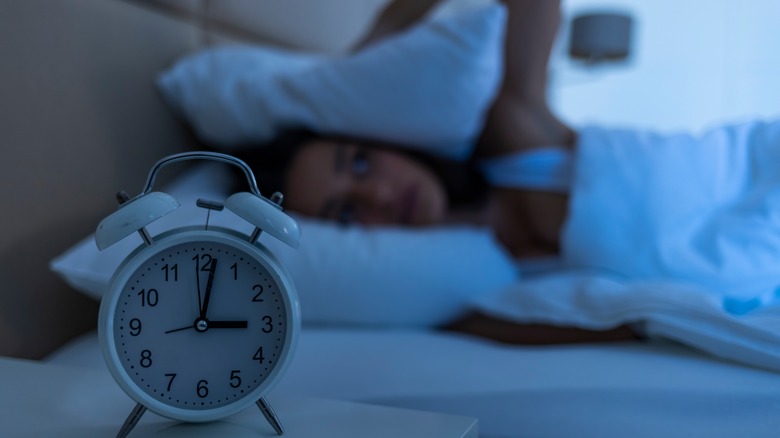Lorazepam Explained: Usage, Doses, And Side Effects
Lorazepam, commonly known by the brand name Ativan, is a psychotropic drug. This means that it is used to treat mood, thought, or behavior disorders (via the Michigan Department of Health and Human Services). More specifically, lorazepam falls in the category of drugs called benzodiazepines (per StatPearls). According to the Drug Enforcement Administration (DEA), benzodiazepines are depressants because they slow down brain activity. Lorazepam is approved by the Federal Drug Administration (FDA) to treat anxiety, anxiety-related insomnia, and seizures, and to produce sedation during surgery. In addition, some off-label, or non-FDA-approved, uses for lorazepam include the treatment of other types of insomnia, panic disorder, alcohol withdrawal, and delirium (via StatPearls).
Like any medication, lorazepam has benefits as well as risks. It can cause various side effects, some that are common and others that are less common but serious. Therefore lorazepam comes with warnings and safety precautions. If you are considering starting this medication, talk with your medical provider who can help you weigh the risks and benefits and determine if lorazepam is right for you.
How lorazepam works
According to an article in Ochsner Journal, lorazepam works by affecting the natural chemical in your brain called gamma amino butyric acid (GABA). GABA inhibits the action of brain cells — or neurons – in turn creating a calming effect on your brain. Your brain has a few types of GABA receptors, which are like docking stations. One of these type of receptors attracts benzodiazepines. Therefore, lorazepam docks at these receptors and changes them chemically so that there is an increase in the amount of GABA throughout your central nervous system (the brain and spinal cord).
Benzodiazepine receptors are highly concentrated in areas such as your limbic system, motor neurons, and the dorsal horn of your spinal cord. Your limbic system is the part of your brain that is involved in behavioral and emotional responses (per The University of Queensland). Thus, slowing down this part of the brain can lead to feeling calmer. Motor neurons are cells that control your physical movements, according to a review in Frontiers in Cellular Neuroscience, so by inhibiting the activity in these cells, lorazepam can slow down seizure activity. And according to a review in Frontiers in Neural Circuits, the dorsal horn is the main site where sensations like pain, temperature, and pressure from any part of your body are processed. This might be how lorazepam helps to, for example, reduce pain perception during a bone marrow biopsy (via a review in Annals of Hematology).
Lorazepam as anxiety treatment
Lorazepam can lower anxiety by slowing down brain activity and causing relaxation (per MedlinePlus). According to an article in Dialogues in Clinical Neuroscience, lorazepam has been shown to be very effective in reducing anxiety. At the same time, the FDA has approved treating anxiety with lorazepam for four months or less because longer use has not been studied in clinical trials. Some experts also recommend short-term use of lorazepam because taking it over a longer period of time can cause dependence on the medication, according to a study in the Pakistan Journal of Pharmaceutical Sciences. If you are considering lorazepam for anxiety but are concerned about becoming dependent on it, talk with your medical provider about other options. Given its habit-forming nature, some experts also recommend working with a multidisciplinary health team that includes various providers such as a therapist, general practitioner, and psychiatrist, so that each can be attentive to signs of misuse or adverse effects of lorazepam (via StatPearls).
Lorazepam as an insomnia treatment
Medical providers do treat insomnia with lorazepam; however, only treatment of anxiety-associated insomnia or lorazepam is FDA-approved, not other types of insomnia (per StatPearls). For some, lorazepam may be a better insomnia treatment option than other medications. As an example, a paper in Breastfeeding Medicine says lorazepam seems to be safe and effective for women with insomnia who are breastfeeding. The paper states that lorazepam has the most information among the benzodiazepines related to use during breastfeeding. It has been deemed safe for infants — while it does pass into breast milk, the concentration is low.
Lorazepam may be safer than trazodone as an insomnia treatment, as found by a study in the Journal of General Internal Medicine. The study found that the risk of a suicide attempt is higher with trazodone than with lorazepam. Insomnia is also becoming more prevalent among the COVID-19 patient group, according to a review in the Journal of Multidisciplinary Healthcare. This review found that the best medication treatment for insomnia overall is a combination of lorazepam and two other drugs: zolpidem and diphenhydramine.
If you or anyone you know is having suicidal thoughts, please call the National Suicide Prevention Lifeline by dialing 988 or by calling 1-800-273-TALK (8255).
Treating seizures with lorazepam
A seizure occurs when there is abnormal electrical activity in the brain. This causes a loss of control of body functions, leading to symptoms such as uncontrollable jerking of the limbs, staring, or loss of consciousness (via Mayo Clinic). An emergency seizure situation is known as convulsive status epilepticus: This is characterized either by a seizure that lasts longer than five minutes or two or more seizures so close together that the person doesn't have time to recover in between (per Epilepsy Foundation). A meta-analysis in the Journal of Clinical Neuroscience found lorazepam to be one of two first-line treatments for these seizures, the other being diazepam.
Lorazepam is taken on an as-needed basis in addition to daily seizure medication. If lorazepam is taken regularly, it might not work as well (via Epilepsy Foundation). To use lorazepam most effectively, make a plan with your healthcare provider for taking it during convulsive status epilepticus, including details such as dose and method of administration.
Lorazepam dosage
According to the FDA, Ativan is available in 0.5-, 1-, and 2-milligram tablets. Most people being treated for anxiety need a starting dose of 2 or 3 milligrams per day — your medical provider will increase the dose gradually depending on how lorazepam affects you. The typical prescription for anxiety for adults and children over age 12 is 2 to 6 milligrams per day, though this amount will be divided between multiple doses (per Mayo Clinic). For older adults, the typical starting dose is 1 to 2 milligrams per day, and for children younger than 12, medical providers determine the starting dose.
For insomnia that is caused by anxiety or situational stress, adults and children who are 12 and older typically take 2 to 4 milligrams in a single dose at bedtime (a doctor will determine a dose for younger children). With regard to older adults, a paper in the Journal of Psychiatry & Neuroscience says that benzodiazepines are no longer recommended for insomnia because they cause memory impairment, fractures, falls, and car accidents.
For convulsive status epilepticus, paramedics can administer lorazepam intravenously prior to arriving at the emergency room, at doses ranging from 2 to 4 milligrams, according to an article in The Neurohospitalist. If you need to administer lorazepam for yourself or a loved one, typically 4 to 8 milligrams can be taken with water, or by dissolving it under the tongue if the person is awake and not in danger of choking (per the Epilepsy Foundation).
Lorazepam can cause common side effects
Because lorazepam slows down brain activity, a common side effect is drowsiness, which is why the largest part of the dose is taken at bedtime (per Healthline). It may also cause other side effects such as dizziness, weakness and balance problems, headaches, gastrointestinal upset such as nausea or constipation, issues with vision, or temporary mood changes. MedlinePlus also lists dry mouth and difficult or frequent urination as possible side effects. Additionally, Medical News Today lists appetite changes as another possible side effect. These side effects tend to go away within a few days to a couple of weeks of starting lorazepam. MedlinePlus recommends informing your medical provider if side effects do not go away or are severe. It's important to remember, though, that this is not an exhaustive list of side effects, so if you experience others, be sure to inform your medical provider.
Lorazepam may affect sex drive
A review in Revista Internacional de Andrología found benzodiazepines to be associated with decreased libido and erectile dysfunction — and a lower sex drive in exchange for less anxiety may not seem like a fair trade-off. However, lorazepam could increase libido as well. In a case reported in European Psychiatry, a 62-year-old woman was treated for insomnia with lorazepam. After her initial dose, she felt an overwhelming sexual desire that faded gradually over a few hours. The authors explain that GABA inhibits serotonin, another chemical in your brain which plays a role in impulse control. Therefore, an increase in GABA from lorazepam may reduce serotonin and lead to greater "impulsivity," or in this case, heightened sexual desire.
Psychiatric Times reports that there is little scientific knowledge on what leads benzodiazepines to cause sexual dysfunction. They may also not affect sex drive at all. A study in Actas Españolas de Psiquiatría of 190 people found that treatment with a different benzodiazepine — alprazolam — did not change libido. Given the contradictory information out there, any change in sex drive due to a benzodiazepine might vary from person to person.
Lorazepam could cause anxiety and depression
Oddly enough, a couple of serious side effects of lorazepam include anxiety and depression (per Medical News Today). While these reactions are rare, it can be puzzling that anxiety is a side effect of a medication that is supposed to treat anxiety. Scientists call this a "paradoxical reaction," and studies have not found a clear reason for why it happens, notes a review in Pharmacotherapy. Other possible paradoxical reactions to lorazepam include aggression, agitation, feelings of rage, and hallucinations (via Medical News Today).
The serious depressive symptom caused by lorazepam is thoughts of suicide or suicide attempts. Warning signs that someone might be thinking about suicide include talking about being a burden to others, speaking of wanting to die, feeling hopeless or talking about not having a reason to live, extreme emotional or physical pain, and isolating oneself from others (per National Institute of Mental Health). If you're on lorazepam and begin experiencing serious side effects such as suicidal ideation, reach out to your doctor immediately.
If you or someone you know needs help with mental health or is having suicidal thoughts, please contact the Crisis Text Line by texting HOME to 741741, call the National Alliance on Mental Illness helpline at 1-800-950-NAMI (6264), visit the National Institute of Mental Health website, or call the National Suicide Prevention Lifeline by dialing 988 or by calling 1-800-273-TALK (8255).
Other serious side effects of lorazepam
In addition to depression and anxiety, other rare but serious side effects of lorazepam include low body temperature, coma, difficulty breathing, yellowish skin or eyes, low blood pressure, speech that is hard to understand, and severe allergic reactions (via Medical News Today). Someone experiencing an allergic reaction may have trouble breathing, tightness in the chest or throat, problems speaking, swelling of face, tongue, or throat, hives, or red, peeling, or blistered skin (per URMC). Side effects are often proportionate with the dose — more severe side effects tend to occur at high doses of lorazepam (per FDA).
According to the FDA, it is possible to become physically and psychologically dependent on lorazepam, and the risk of dependence is greater with higher doses. The DEA also reports that benzodiazepines are sometimes abused by adolescents and young adults to get high, as they can mimic the effects of alcohol and sleeping pills in the body.
Warnings and drug interactions with lorazepam
You want to avoid lorazepam if you have sleep apnea, severe breathing problems, or acute narrow-angle glaucoma (per StatPearls). It is also recommended that lorazepam — or benzodiazepines in general — not be the first go-to treatment for any psychiatric symptoms if you are in the first or third trimester of pregnancy (via StatPearls). It is also important for a person to avoid lorazepam if they are using illicit substances or misusing other drugs such as alcohol or marijuana (via WebMD). In addition, using a benzodiazepine with opioids can cause extreme sedation, breathing problems, coma, and death (per StatPearls).
Another important thing to consider is that there are other drugs or medications that can interact with lorazepam, causing unwanted . According to MedlinePlus, lorazepam can interact with pain medications like codeine, hydrocodone, morphine, fentanyl, hydromorphone, methadone, oxycodone, and tramadol — and these interactions could cause breathing problems, unresponsiveness, severe dizziness, intense lightheadedness, and extreme sleepiness.
Important precautions before and while taking lorazepam
Before starting lorazepam, URMC recommends telling your medical provider if you have any medication or food allergies, glaucoma, kidney disease, liver disease, lung disease, sleep or breathing problems, psychiatric disorders, personal or family history of a substance use disorder, if you are pregnant or plan to become pregnant, or if you are breastfeeding or plan to breastfeed. You also want to tell your provider of any medications, over-the-counter (OTC) drugs, or supplements you are currently taking, as they might interact with lorazepam.
If you do take lorazepam, it is important to take the medication exactly as directed by your provider. Since lorazepam can interact with other drugs, it is also important to talk with your medical provider before adding anything new to your routine. And because lorazepam can cause drowsiness and dizziness, it is important to avoid driving or operating heavy machinery until you know how it affects you.
Be sure to contact your prescriber of lorazepam if your symptoms do not get better or become worse. Get emergency medical attention if you have a significant change in balance, depressed mood, or a severe allergic reaction. Also call emergency services if seizures get worse or are different after starting lorazepam. And if you have taken lorazepam for 10 days or more, it is important that you do not stop taking it on your own — because the medication is habit-forming, suddenly stopping it can cause withdrawal symptoms. Instead, contact your prescriber, and they can help wean you off of lorazepam by slowly reducing the dose over time.












